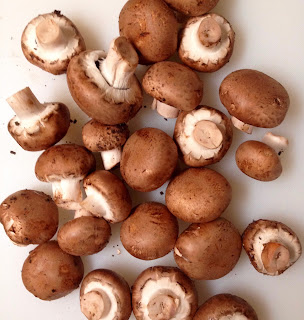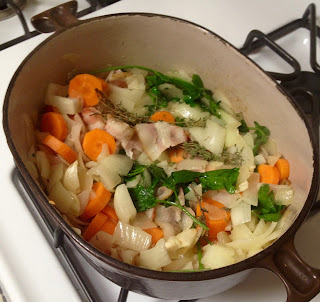As promised earlier this month, this blog has not heard the last of Ruth Reichl’s latest book (Random House 2015). Completely coincidentally, while Ruth wrote of yet another snowstorm marooning her and her husband in their upstate New York house, we here in the city had our first plunge in temperatures. With not a snowflake in sight nor any on the horizon, this recipe called to me nonetheless. First of all, what is more warming than stew? And what tastes better than a stew left overnight where it develops even more flavor? You take it out of the refrigerator then next day, peel away the layer of fat and continue slowly reheating the dish. Andrew was away this past weekend and so I turned Sunday into a leisurely day of stew making so that I could turn Monday night, when the temperature took its nosedive, into stew night. What makes this particular stew so extraordinary? And why isn’t it a recipe for Boeuf Bourguignon? It sure comes darn close with its ingredient list almost identical however this is Ruth’s stew and it’s well worth putting on your winter cooking list.
I’ve arrived at page 110, just a third of the way through “My Kitchen Year”. Ruth’s confidence in my cooking skills seems to be building as she gets almost loosey-goosey in her instructions. She tells me to ‘take as many onions as you feel like chopping’. Now these are not the precise directions I’m used to following. I quickly scan the ingredient list and aside from the onions, the quantities for everything else are listed precisely…or are they? Back to the recipe, I am told to add ‘any herbs you might have on hand’. Ruth, I must remind myself, is snowbound. I am just a few blocks away from Fairway Market. Onward I proceed to brown the beef as
carefully instructed and then cover my beef and vegetables with ‘most of a bottle of decent red wine’, a mixture I will simmer ‘for 3 to 4 hours’. Now I am not pretending that I need total hand-holding in the kitchen. However there was a sense of let go and let God about this recipe. And fortunately, Ruth’s Beef, Wine and Onion Stew is an absolute keeper. It has great depth of flavor. It’s just the right amount of rich. It was every bit as comforting as I’d hoped. I even went so far as to ignore Ruth’s suggested boiled potato accompaniment and went for a pillow of creamy mashed potatoes instead. Maybe I really don’t need recipes to be as precise as I usually follow…. But here it is, just as printed.
Salt
1.Take as many onions as you feel like chopping and throw them into a casserole with a bit of butter and a couple of strips of bacon, cut into little squares.
2. Add a couple of carrots, cut into whatever size you consider edible. Cook them together until they are fragrant and just a bit golden. Add a few cloves of garlic, smashed, to the mix, and any herbs you happen to have on hand; thyme is nice, as is parsley, although personally I’d stay away from tarragon and rosemary. When they’ve all turned soft, add a squirt of tomato paste (it adds a touch of sweetness), stir for a minute or so and put the entire potful into a bowl to wait.
3.Melt a splash of oil and a pat of butter in the same pan. While it heats take a couple pounds of beef, cut up for stew, and pat it dry. Salt and pepper the cubes, then toss them in a bag with a bit of flour and shake until they look like they’ve been dusted with snow.
4. Cook the beef in flights – it hates being crowded in the pan – until beautifully brown, and then set aside with the onions.
5. When all the beef has browned, deglaze the pan with ¾ cup of cognac. Return the beef and vegetables to the pot, cover them with most of a bottle of decent red wine and throw in a stalk of celery and a bay leaf if you’ve got them. Simmer gently, partly covered, for three or four hours. The aroma will fill your house and make you very happy.
6. Just before serving sauté some mushrooms, sliced, in a nice amount of butter for about ten minutes, adding salt and pepper at the end. Toss them into the stew and taste it. If it needs salt, pepper or more wine, add it.





















